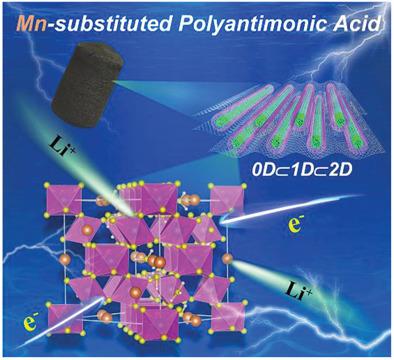Our official English website, www.x-mol.net, welcomes your
feedback! (Note: you will need to create a separate account there.)
Mn‐Substituted Tunnel‐Type Polyantimonic Acid Confined in a Multidimensional Integrated Architecture Enabling Superfast‐Charging Lithium‐Ion Battery Anodes
Advanced Science ( IF 14.3 ) Pub Date : 2020-11-25 , DOI: 10.1002/advs.202002866 Boya Wang 1 , Yunhong Wei 1 , Haoyu Fang 1 , Xiaoling Qiu 1 , Qiaobao Zhang 2 , Hao Wu 1 , Qian Wang 1 , Yun Zhang 1 , Xiaobo Ji 3
Advanced Science ( IF 14.3 ) Pub Date : 2020-11-25 , DOI: 10.1002/advs.202002866 Boya Wang 1 , Yunhong Wei 1 , Haoyu Fang 1 , Xiaoling Qiu 1 , Qiaobao Zhang 2 , Hao Wu 1 , Qian Wang 1 , Yun Zhang 1 , Xiaobo Ji 3
Affiliation

|
Given the inherent features of open tunnel‐like pyrochlore crystal frameworks and pentavalent antimony species, polyantimonic acid (PAA) is an appealing conversion/alloying‐type anode material with fast solid‐phase ionic diffusion and multielectron reactions for lithium‐ion batteries. Yet, enhancing the electronic conductivity and structural stability are two key issues in exploiting high‐rate and long‐life PAA‐based electrodes. Herein, these challenges are addressed by engineering a novel multidimensional integrated architecture, which consists of 0D Mn‐substituted PAA nanocrystals embedded in 1D tubular graphene scrolls that are co‐assembled with 2D N‐doped graphene sheets. The integrated advantages of each subunit synergistically establish a robust and conductive 3D electrode framework with omnidirectional electron/ion transport network. Computational simulations combined with experiments reveal that the partial‐substitution of H3O+ by Mn2+ into the tunnel sites of PAA can regulate its electronic structure to narrow the bandgap with increased intrinsic electronic conductivity and reduce the Li+ diffusion barrier. All above merits enable improved reaction kinetics, adaptive volume expansion, and relieved dissolution of active Mn2+/Sb5+ species in the electrode materials, thus exhibiting ultrahigh rate capacity (238 mAh g−1 at 30.0 A g−1), superfast‐charging capability (fully charged with 56% initial capacity for ≈17 s at 80.0 A g−1) and durable cycling performance (over 1000 cycles).
中文翻译:

限制在多维集成架构中的锰取代隧道型聚锑酸可实现超快充电锂离子电池阳极
鉴于开放隧道状烧绿石晶体框架和五价锑物质的固有特征,聚锑酸(PAA)是一种有吸引力的转化/合金型负极材料,具有快速固相离子扩散和多电子反应,适用于锂离子电池。然而,提高电子电导率和结构稳定性是开发高倍率和长寿命 PAA 基电极的两个关键问题。在此,这些挑战通过设计一种新颖的多维集成架构来解决,该架构由嵌入一维管状石墨烯卷中的 0D Mn 取代的 PAA 纳米晶体组成,该卷与 2D N 掺杂石墨烯片共同组装。每个子单元的综合优势协同建立一个具有全向电子/离子传输网络的坚固且导电的3D电极框架。计算模拟结合实验表明, Mn 2+部分取代H 3 O +进入PAA的隧道位点可以调节其电子结构,从而缩小带隙,增加本征电子电导率,并降低Li +扩散势垒。所有上述优点能够改善电极材料中的反应动力学、自适应体积膨胀和减轻活性Mn 2+ /Sb 5+物质的溶解,从而表现出超高倍率容量( 30.0 A g -1时为238 mAh g -1)、超快‐充电能力(在 80.0 A g -1下充满 56% 初始容量约 17 秒)和持久的循环性能(超过 1000 次循环)。
更新日期:2021-02-03
中文翻译:

限制在多维集成架构中的锰取代隧道型聚锑酸可实现超快充电锂离子电池阳极
鉴于开放隧道状烧绿石晶体框架和五价锑物质的固有特征,聚锑酸(PAA)是一种有吸引力的转化/合金型负极材料,具有快速固相离子扩散和多电子反应,适用于锂离子电池。然而,提高电子电导率和结构稳定性是开发高倍率和长寿命 PAA 基电极的两个关键问题。在此,这些挑战通过设计一种新颖的多维集成架构来解决,该架构由嵌入一维管状石墨烯卷中的 0D Mn 取代的 PAA 纳米晶体组成,该卷与 2D N 掺杂石墨烯片共同组装。每个子单元的综合优势协同建立一个具有全向电子/离子传输网络的坚固且导电的3D电极框架。计算模拟结合实验表明, Mn 2+部分取代H 3 O +进入PAA的隧道位点可以调节其电子结构,从而缩小带隙,增加本征电子电导率,并降低Li +扩散势垒。所有上述优点能够改善电极材料中的反应动力学、自适应体积膨胀和减轻活性Mn 2+ /Sb 5+物质的溶解,从而表现出超高倍率容量( 30.0 A g -1时为238 mAh g -1)、超快‐充电能力(在 80.0 A g -1下充满 56% 初始容量约 17 秒)和持久的循环性能(超过 1000 次循环)。











































 京公网安备 11010802027423号
京公网安备 11010802027423号